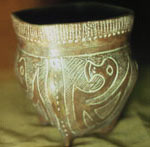A Brief History of Hopewell Culture National Historical Park

In 1923, Mound City was declared a National Monument and opened to the public under the management of the Ohio Archaeological and Historical Society. The park was used mainly for recreation and to view the mounds (below right). There was little or no emphasis on interpreting the prehistoric site for visitors. It was not until 1942 that a kitchen area within the picnic shelter was remodeled in order to create a museum display. Albert C. Spetnagle, a Ross County businessman, donated money and artifacts from his personal collection to fill the small display area. The museum became a popular tourist attraction during
World War II. In 1946, management of the park was transferred to the
National Park Service. The museum display at the picnic shelter (below left) was dismantled and the artifacts were returned to their owner.
 Duck pot excavated from Mound City Group
Duck pot excavated from Mound City Group
Clyde B. King (left) became the first permanent superintendent of the park in 1946. He created new exhibits in the shelter museum that included both cultural and natural history exhibits.
Natural history specimens were donated to Mound City by national parks throughout the United States. These specimens were the first objects accessioned in Mound City's museum collections. The objects included
obsidian from Yellowstone National Park, freshwater
mussels from the Scioto River,
shark teeth from Fort Jefferson National Monument,
copper ore from Isle Royale, and
marine shells from the
Gulf of Mexico.
 Hopewell Culture National Historical Park is located in south-central Ohio at the foothills of the Appalachian Mountains
Hopewell Culture National Historical Park is located in south-central Ohio at the foothills of the Appalachian Mountains
 Obsidian has been found at a few Hopewell earthwork sites. The majority of obsidian, several hundred pounds, was found in one mound at Hopewell Mound Group. Some of the obsidian was from Yellowstone National Park in Wyoming- over 1,500 miles away
Obsidian has been found at a few Hopewell earthwork sites. The majority of obsidian, several hundred pounds, was found in one mound at Hopewell Mound Group. Some of the obsidian was from Yellowstone National Park in Wyoming- over 1,500 miles away
These objects represented the raw materials used by the Hopewell to make decorative and ceremonial items. Superintendent King continued to work toward reducing the emphasis on public recreation at the park and encourage historical interpretation of the site for visitors. In 1960, his efforts were rewarded with the dedication of a new visitor center at its present location. The center included a museum display area to exhibit artifacts recovered from excavations at Mound City. During the 1960s and 1970s, artifacts recovered during previous excavations and stored at the Ohio Historical Society were accessioned into the park collections.
 Mound City Group
Mound City Group
There are now literally thousands of objects in the park's museum and collections storage. They include not only Hopewell (200 BC - AD 500) cultural remains, but also artifacts from all prehistoric and historic time periods. Camp Sherman (AD 1917-1921) blankets and buttons from soldiers' uniforms are stored in a case next to one that houses Fort Ancient (AD 1000-1500) pottery.
Paleoindian (10,000-8000 BC) and
Archaic (8000 BC - 1000 BC) projectile points are stored in a case across the aisle. Bone tools manufactured by the
Intrusive Mound Culture (AD 800-900) can be found two rows over.
These objects are made from many different materials including shell, bone, stone, copper, paper, iron, glass, clay and vegetal fibers. The collections storage also houses botanical specimens collected over the last seven decades from different sites throughout the park, and the park archival records including photographs, archeological field forms, original documents, maps and copies of reports. The main function of the collections is to preserve these artifacts for education, research, documentation and future generations.
http://www.nps.gov/archive/hocu/html/MChistory.html

